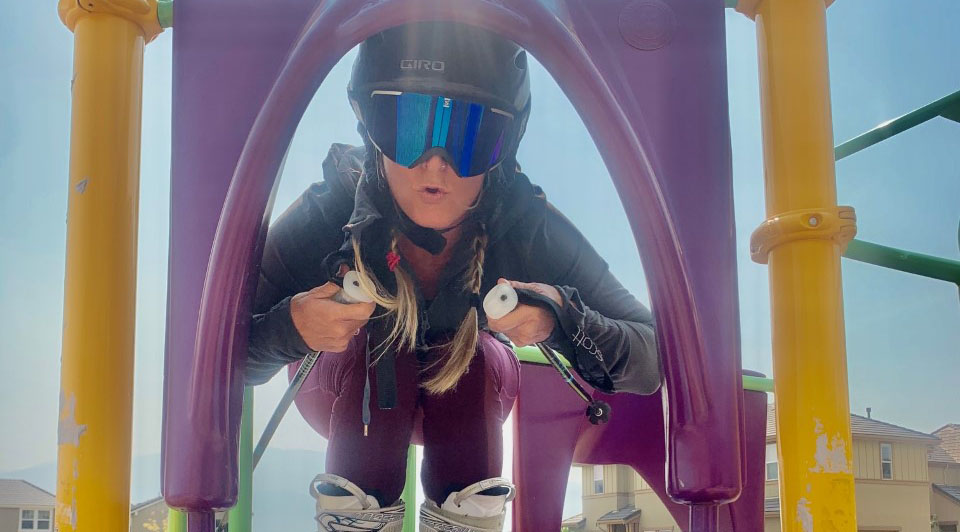
Winter is Coming. Get in Shape for Ski Season
Alder Creek Adventure Center, Association News, Cross Country Ski Area, Downhill Ski Area, Trout Creek Recreation CenterBy Karen Caton-Brunings, CFT, SET, CLC, CHC
Can you feel it? The shadows are getting longer; the days are getting shorter. It’s the time of year when we watch old Warren Miller movies and dust off our winter sports equipment while daydreaming of schussing down the mountain or skating across a still and peaceful trail on a perfect snow globe day. It is also the time when we wonder if we are ready for the physical demands of the winter sports we love, like downhill and Nordic skiing, snowboarding and snowshoeing.
Whether you are shredding the backcountry, skating trails or cruising on groomers, snow sports are complex and dynamic. Your fall training should address five fitness areas:
- CARDIO
- STRENGTH
- BALANCE
- FLEXIBILITY
- NUTRITION/HYDRATION
It’s been a long summer. COVID-19 restrictions and air quality have made training challenging for many. Remember to start training slowly and listen to your body. There is no need to train like an Olympic downhill skier if you fancy the groomed runs. Your training should match your activity and level. The goal is building up safely and slowly so that you start the season a bit stronger than your activity level requires.

CARDIO
Cardiovascular fitness is crucial. Without it, fatigue sets in and muscles tire more quickly. Cardiovascular exercise includes cycling, running, hiking, swimming, paddleboarding and working with indoor cardio equipment. Spend at least 30 minutes 2-3 times per week working on your cardiovascular strength and endurance. Pick activities you enjoy, and switch it up to decrease boredom. Cross-training also helps in injury prevention.
There are many cardio exercises that can get your blood pumping, especially when you think outside the box. For example, if you’re not into running, try dancing. Search YouTube videos for free cardio classes, cardio martial arts practices or a high-intensity interval training (HIIT) workout.
STRENGTH
Gaining core and leg strength is a top priority in preparation for the ski season, but ignoring upper body strengthening can leave you open for a shoulder or back injury. A balanced approach is a key component to prevent and protect from injury.
It is important to train the myriad of muscles in the leg: quadriceps, hamstrings, hips, glutes and calves. The same is true for the upper body. Balance is key. Overdevelopment in one area can increase the possibility of injury. A comprehensive, total-body strength workout routine or a split workout (lower body one day, upper body the next) are solid approaches to gaining strength in the preseason. Be sure to give yourself a day between your strength workouts. There are a lot of online resources to help you develop a ski training program that meets your needs. When in doubt, consult a fitness professional to assist you.
BALANCE
The fancy term for balance is proprioception, which means knowing where your body parts are in space and relative to each other. It helps us avoid falling while skiing or snowboarding. Snow is an ever-changing, undulating surface. Balance boards, stability disks, BOSU Balance Trainers and slacklines can help you work on your stability and balance. However, you have everything you need to practice without a purchase from the store. Single-leg balancing and hopping laterally, or front and back while maintaining your balance, are excellent ways to balance train. You can also use a rolled-up towel or throw pillow underfoot to provide an unstable surface when balancing on one foot. Add a few minutes of balance training on your cardio days to double-up your preparedness.

FLEXIBILITY
Winter sports require quick, sudden, sporadic and sometimes stressful movements on muscles and ligaments. Stretching can reduce the likelihood of soreness or injury. One of the most effective ways to incorporate is with yoga. Yoga is a comprehensive way to stretch muscles used while skiing. If COVID-19 restrictions make it difficult to attend a live class, you can find short, ski-specific classes online. A popular YouTube yoga series called “Yoga with Adriene” creates yoga flows for all skill levels.
NUTRITION
Food is fuel. Après after a day of skiing and post-workout pizza and beer are delicious, but the right choices can make a difference in performance, gains and recovery. The right foods don’t have to be expensive or time-consuming.
Pre-workout foods should contain protein to support your muscles and complex carbohydrates to give you energy for your workout or ski day like yogurt and granola, a breakfast burrito or whole-grain avocado toast with egg. Chili fries after a ski day sound delicious, but your body has roughly 30 minutes after a workout or ski session when it’s most receptive to taking in nutrients. Support your hard work with a quick recovery snack that is high in protein and carbs like yogurt and granola, chocolate milk or protein bar. Eat the chili fries after that if an après is in order.
Pre-season training and ski days can cause muscle soreness and inflammation. You can combat this by eating foods rich in Omega-3 fats like walnuts, flaxseed, salmon and Omega-3 enriched eggs. Olive oil, dark green veggies and deep-colored fruits contain antioxidants that can reduce inflammation and support joint health as well.
Lastly, the National Academies of Sciences, Engineering and Medicine determined that adequate daily fluid intake is about 15.5 cups (3.7 liters) of fluids for men and about 11.5 cups (2.7 liters) of fluids a day for women. Your body loses water through respiration at high altitudes twice as fast as it does at sea level. It is recommended to drink 1-3 liters of water and include electrolytes when exercising in cold weather and high altitudes.
Sound like a lot? Don’t be daunted. A little preparation and sweat, both before and during the season, will help you safely tear up the slopes from opening day until the daffodils bloom.


